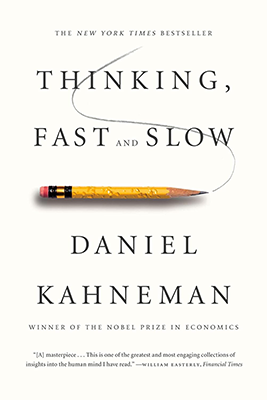Thinking Fast and Slow
“Thinking, Fast and Slow” by Daniel Kahneman is a book that explores the two systems of thinking that drive human decision-making: the fast, intuitive, and emotional System 1, and the slow, deliberate, and logical System 2. Here’s a summary of its key points:
System 1 and System 2: Kahneman introduces the concept of System 1 and System 2 thinking. System 1 operates automatically and quickly, relying on intuition, heuristics, and emotions, while System 2 is slower and more deliberate, relying on logic, reasoning, and conscious effort.
Cognitive Biases: The book explores various cognitive biases and heuristics that influence decision-making, such as anchoring, availability, and confirmation bias. Kahneman discusses how these biases can lead to errors in judgment and decision-making, and provides examples from psychology and behavioral economics.
Prospect Theory: Kahneman and Amos Tversky developed prospect theory, which describes how people make decisions under uncertainty. The theory suggests that individuals weigh potential gains and losses differently, and are more sensitive to losses than gains—a concept known as loss aversion.
Heuristics and Biases: Kahneman discusses how heuristics, or mental shortcuts, can lead to cognitive biases and errors in judgment. He explores various heuristics, such as the representativeness heuristic and the availability heuristic, and explains how they can influence decision-making.
Overconfidence and Planning Fallacy: The book examines the concepts of overconfidence and the planning fallacy, which describe our tendency to be overly optimistic about our abilities and future outcomes. Kahneman discusses how these biases can lead to poor decision-making and unrealistically optimistic expectations.
Regression to the Mean: Kahneman discusses the concept of regression to the mean, which describes the tendency for extreme outcomes to return to the average over time. He explains how failure to account for regression to the mean can lead to erroneous conclusions and misinterpretations of data.
Happiness and Well-Being: The book explores the psychology of happiness and well-being, and how our perceptions of happiness are influenced by factors such as memory, attention, and the experiencing self versus the remembering self. Kahneman discusses the limitations of traditional economic measures of well-being and proposes alternative approaches to understanding happiness.
Implications for Decision-Making: Kahneman concludes with practical implications for decision-making in various domains, such as finance, medicine, and public policy. He emphasizes the importance of recognizing and mitigating cognitive biases, using structured decision-making processes, and seeking feedback to improve decision quality.
Overall, “Thinking, Fast and Slow” offers a comprehensive and insightful exploration of human decision-making and the factors that influence our judgments and choices. Whether you’re a psychologist, economist, business leader, or simply interested in understanding the workings of the mind, Kahneman’s book provides valuable insights into the complexities of human cognition and behavior.

